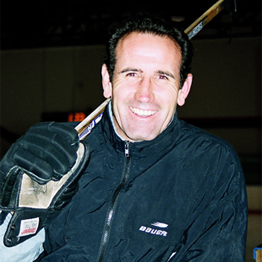Exercise Professionals
- The strength and conditioning program should be prescribed by an qualified exercise professional. A qualified exercise professional should have a good combination of documented formal education, knowledge of hockey physiology, and experience at training hockey players.
- Education requirements can range from a degree in kinesiology, physical education or exercise physiology, to certification as a personal trainer. It is highly recommended that the exercise professional has some kind of formal education.
Off-Ice Fitness Relating to Skating
- The off-ice fitness variables that have consistently been found (by research) to predict skating speed and acceleration for male and female hockey players of any age and skill level include: vertical jump height and 40 yard dash time. (Blatherwick, 1989, Blatherwick, et al, 1985, Bracko, 1997, Bracko, 1999 and Mascaro, et al. 1992)
- Vertical jump can be enhanced by performing plyometrics or jump training.
- In addition to vertical jump and 40 yard dash, other off-ice fitness variables that predict skating performance include (Bracko, 1997):
– Push-ups/minute
– Sit-ups/minutes
– Hamstring Flexibility
- This is not to say however, that if a hockey player increases his or her vertical jump height, 40 yard dash time, push-ups and sit-ups/minute and hamstring flexibility, he or she will automatically become a better skater.
- It is important to understand that skating is a very complex motor skill. High performance skating takes many years to acquire. Therefore, the research evidence which will be presented later on this page, indicates that at young ages, improvements in fitness do not have a drastic impact on skating performance. This means that, at a young age, the best way to improve skating performance, is to skate. A strength and conditioning program will help with strength, power and endurance which can enhance performance. A hockey player has to first of all become a proficient skater and to be able to coordinate his or her movement patterns, before off-ice fitness will make drastic improvements in skating ability.
- Now remember, the best way to improve skating is to skate like you skate during a game! Balancing on one foot for extended periods of time, doing the polka on the ice, doing the “duck walk” or shoot the duck will not improve your game-performance skating. Doing drills like this will only help you balance on one foot (which is never done during a game), become a better dancer, and improve unnatural balance positions. For more information on skating instruction please go to the Skating Page on this web site.
- This is not to say that strength and conditioning will not help a young hockey player. On the contrary, there are numerous advantages to improving the fitness level of a young hockey player.
- At older ages, when a hockey player has high-performance muscle memory for skating, strength and conditioning may be the key to improving skating acceleration, speed and balance.
- Electromyographic studies (placing electrodes on the skin to measure the electrical activity of the muscles) of ice skating have shown that the vastus medialis and vastus lateralis have the most activity during the propulsion phase of skating (Halliwell, 1978, Kumamoto, et al, 1972 and Mashima, et al, 1972). The two muscle mentioned above are part of the muscle group known as the quadriceps (the big muscle on the front of the thigh). The quadriceps appears to be an important muscle for skating.The other muscles that are important for skating performance include the gluteus maximus (the buttocks), and the muscles on the inside (adductors) and outside (abductors) of the hip. More about the hip adductors and abductors later.
- It appears that lower body, upper body and total body fitness variables predict skating performance. It seems warranted to suggest that hockey players should engage in a multi-faceted approach to off-ice training. Following is an cursory look at a strength and conditioning program for hockey players.
- An important component of an off-ice training program is strength training. The components of muscle fitness that should be emphasized include: strength, power, and endurance. Improvements in strength, power and endurance can be accomplished with or without weights.
- Cardiovascular Endurance and Power . . . Anaerobic / Aerobic training. The specificity of training rule would suggest the best type of training for the cardiovascular system of a hockey player is interval training. Interval training can be any activity that is performed for a medium to long period of time 15 – 30 min) with alternating periods of high intensity and low intensity exercise.
- Arnett (1996) found that the recovery of college hockey players was enhanced from pre-season to post-season after a entire hockey season which consisting of no aerobic type training. The on-ice practices Arnett (1996) describes were high intensity short duration type training.
- This means that being able to recover from high intensity on-ice work is essential for a hockey player. This may be best accomplished by performing interval training during the off-season.
- Flexibility. Less focus on stretching the hip adductors (groin) and more focus on the other body parts, especially the hip abductors.
- Hip range of motion exercises are important for hockey players, especially defensemen. The ability to internally and externally rotate the hips is important for high-performance skating.
- Any strength and conditioning program for hockey players should follow a periodized protocol and not just progressively overload the body with increased weight and intensity of exercise.
- A periodized training program has alternating cycles of high, medium and low intensity training for both muscle, and cardiovascular, fitness.
- Periodization has been found to be the most effective protocol to enhance the fitness of high-performance athletes.
Injury Prevention
